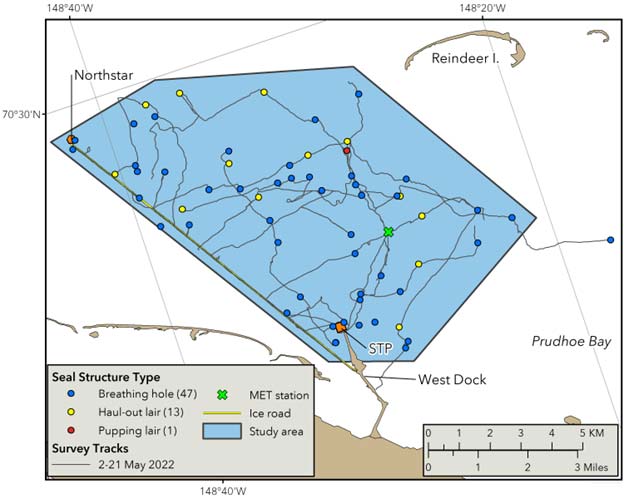Winter Ringed Seal Density
Within Beaufort Sea Oil and Gas Project Areas
2022
In May 2022, we found 61 ringed seal structures (47 breathing holes and 14 lairs) in an 88.2 km2 area; a density of 0.68 structures/km2. Fewer structures were identified in 1983 (43; 16 breathing holes and 27 lairs) in a 96.8 km2 area; a density of 0.44 structures/km2. Snow depths at lairs were similar between studies and averaged 76.9 cm (range 45–120 cm) in 2022 compared to 78.7 cm (range 45–130 cm) in 1983. Lairs (12 of 14) were instrumented with temperature sensors, light sensors, and cameras to record lair use. Temperature sensors detected 11 haul-out bouts in four lairs, however photographs revealed extensive use of access holes for resting without hauling out and with minimal and brief increases in lair temperature. Breathing holes were found in water as shallow as 2 m and active structures were found within 19.5 m of facilities and within an active ice road. Two different basking seals were observed to stay on the ice during the close passage of a hovercraft.

2023
In April and May 2023, we found 73 ringed seal structures (60 breathing holes, 10 lairs, and 3 unknowns) in an 88.2 km2 area; a density of 0.83 structures/km2. Fewer structures were identified in 1983 (57; 20 breathing holes and 37 lairs) in a 96.8 km2 area; a density of 0.59 structures/km2 and in 2022 (61; 47 breathing holes and 14 lairs); a density of 0.69 structures/km2. Snow depths at lairs were shallower in 2023 than in 1983 and 2022 and averaged 56.6 cm (range 40–75 cm) in 2023 compared to 78.7 cm (range 45–130 cm) in 1983 and 76.9 cm (range 45–120 cm) in 2022. Four lairs were instrumented with temperature and light sensors and cameras to record lair use. In 2023, we monitored 10 breathing holes that had been opened for basking with cameras to record use by multiple seals, visitation by predators, and other behavior. Temperature sensors instrumented on four lairs did not detect any haul-out bouts, however photographs revealed extensive use of access holes for resting without hauling out and with minimal and brief increases in lair temperature. Breathing holes were found in water as shallow as 2 m and active structures were found within 19.5 m of facilities and within an active ice road.

